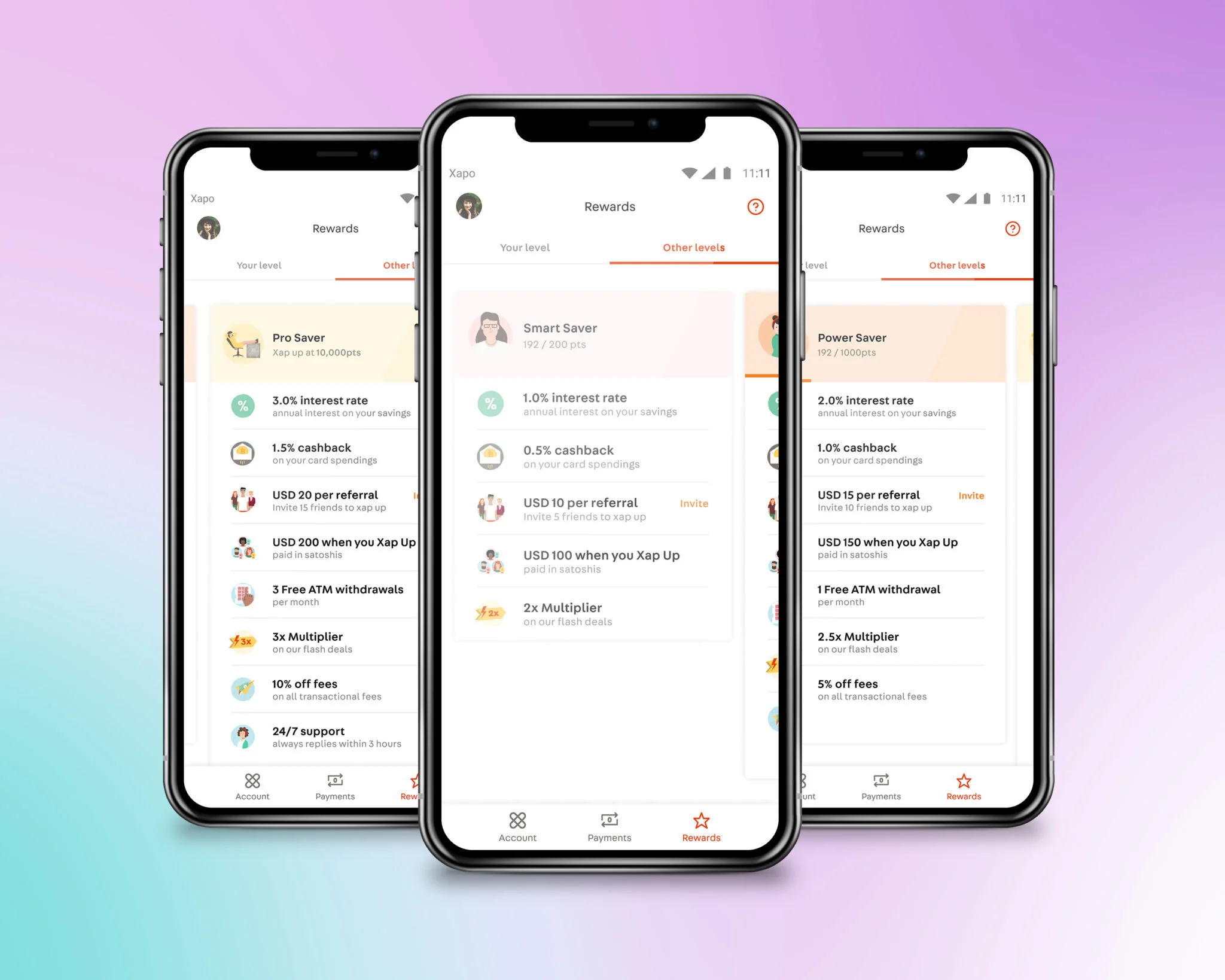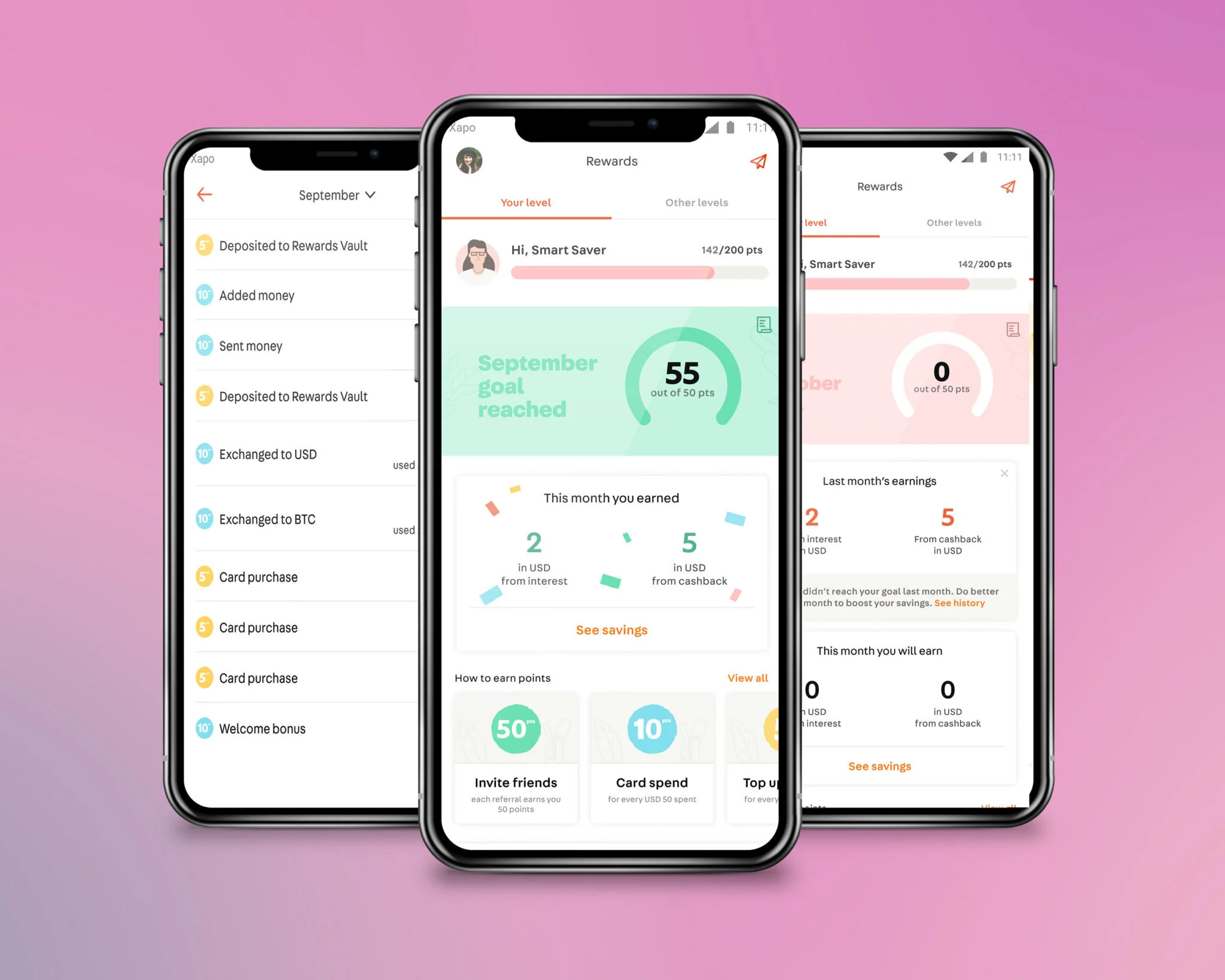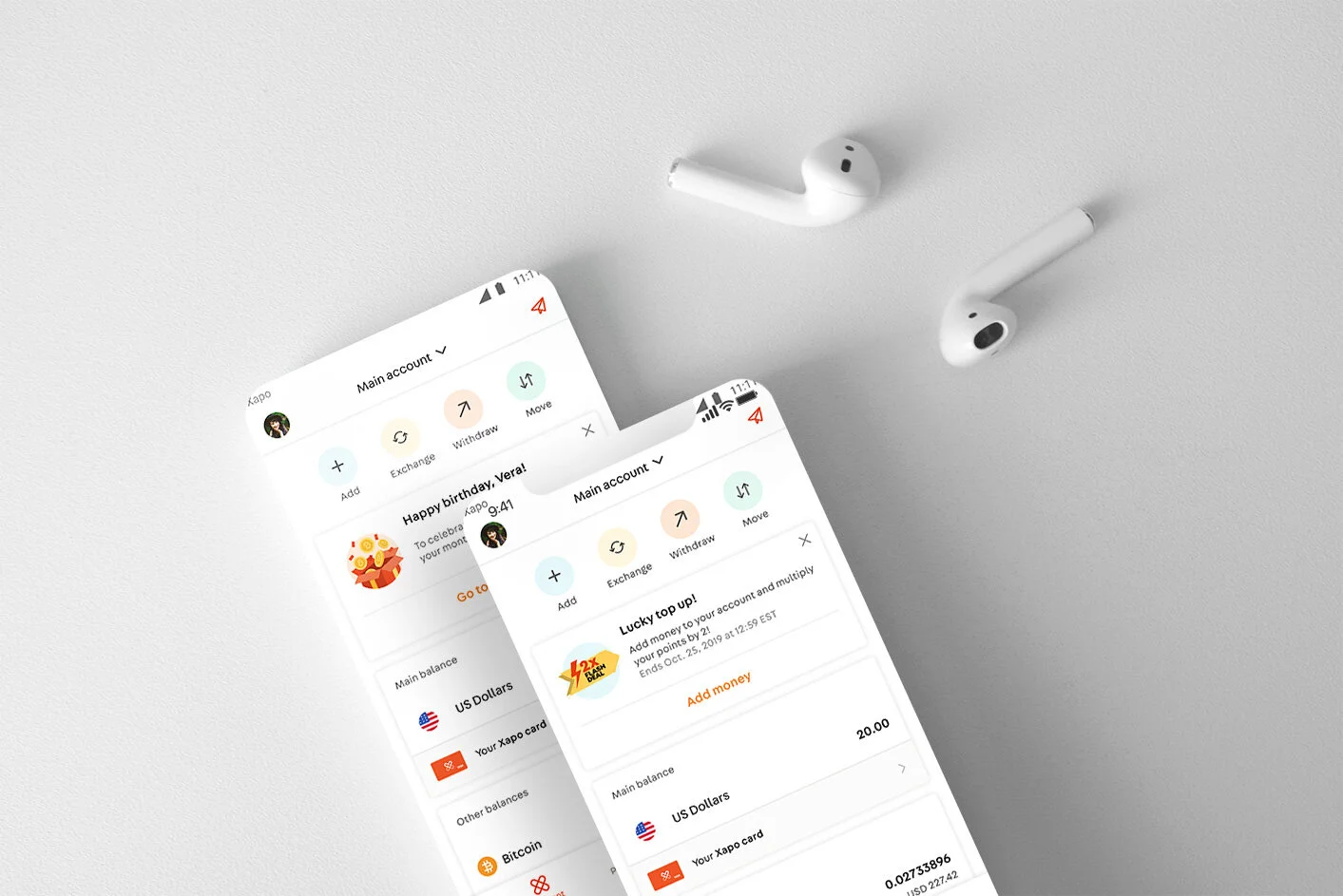A bank that rewards you… a Hackathon-winning story
Back in October 2019 Xapo decided to do their second hackathon. I participated in both. The first time around, my team came second, but this one … we won.
The Team.
In October, my team consisted of 5 people spread across 4 different locations – UK, Uruguay, Macedonia, Spain. Exciting, right? My team probably sounds a bit odd, but I was the one who gathered this group of extremely talented & knowledgable individuals.
Based on my experience in the previous hackathon, my recruitment decisions were highly strategic.
Chloe was also part of my team the first time around. She was able to recruit participants for moderated usability tests pretty quickly and get the insights we so desperately needed.
Meri, our content writer, managed all the communications. Extremely useful if you want to design an end-to-end user experience.
Dani could help build the prototype, which was part of the deliverables. At the time we were using an in-house prototyping tool.
Gercho was an Android specialist, working closely with me on cards. His participation was of high importance as we needed someone to investigate the feasibility of the solution and identify possible technical constraints.
An unfairly advantaged grouping you might say, but smooth, fast, and efficient collaboration was what I had learned we needed to improve upon through coming second in the previous hackathon.
What it was all about?
The theme was Rewards. In the area of banking, this can be a tricky subject. When we got the brief, we felt the solution we were given as a jump-off point, seemed too … shady in terms of how rewards are earned. And this is how the solution turned into the problem we tried to solve.
Objectives
Xapo Rewards (XR) is a tool to drive virality and engagement to our various products. By interacting with our services a user can earn points that accumulate and translate to levels. Higher levels include greater monetary and non-monetary benefits.
We had to focus on two key KPIs:
Virality
Users invite their friends to Xapo
Engagement
Users login and interact with our products more often
Purpose
Engagement tool.
Xapo Rewards is meant to drive interaction to products that affect the fundamental KPIs of our business.
Introduction to new features.
Xapo Rewards should drive a user to test products that are new or that they were unaware of. That will help us drive critical mass to products and understand how to improve them faster.
Earn from Using.
Xapo Rewards provides rewards in BTC that increases the more they use Xapo and invite their friends.
Reduce churn.
Xapo Rewards’ benefits may drive users to return more often to our app over time, thus reducing the chances of a user becoming dormant
Nudge users to behave like power users.
Once we identify the conditions that define a power user, we can incentivize regular users to behave like one. Power users are those that maximize our revenues or help reduce acquisition costs.
The Four Pillars
Points and Levels.
XR is driven by points that are earned when a user completes an action inside Xapo. Once a user earns enough points they will upgrade to new levels. Each increasing level has better rewards, benefits, etc…
SAT giveaway.
Upon gaining a certain amount of points users also earn Satoshis. As their level increases, it becomes harder to earn Satoshis, however, the prizes are bigger. SAT giveaways are collected in their Bitcoin Stacking Wallet.
By the way, 1 SAT = 0.00000001 BTC
1 USD = 10,000 SAT (@ $10k BTC price)
Bitcoin Stacking Wallet.
The Bitcoin Stacking Wallet is the default BTC wallet with additional features. Since users receive prizes in SAT they collect them in this wallet.
Referrals.
XR is all about virality, referrals, and getting users to invite their friends is a big part of the program. At the most basic and current level, users get $10 USD in BTC for inviting friends who verify their accounts and complete the first top-up of $100. As their levels increase the users will get even more money for inviting their friends who complete this.
We will take it one step further and allow users to get points for the actions completed by the friends they referred. In other words, you get points when your referrals do things that get them points. We will build the system in such a way that once you reach a certain level you can only increase if you have help from your friends.
So let’s say I invite my pal Lisa to Xapo. Both me and Lisa will earn a small monetary reward if she chooses to join Xapo. Lisa and I both will receive money if we perform certain actions within Xapo. The tricky bit was I will also receive rewards for the actions Lisa performs in Xapo. Not only that, but I will also earn smaller rewards from the people she invites to Xapo and the actions they perform. Things start to feel even shadier for some people when you say, you earn rewards in bitcoin.
At this point we said…. hold on.
This somehow did not sit right with us. Worth mentioning we had 5 days to come up with a solution, prototype & wite and design a winning presentation by still doing our day to day jobs.
We went around in circles for a bit looking for the best idea which included gamification, shared rewards, but we couldn’t yet formulate a fully developed solution.
Testing.
We decided we needed to recruit a few users quickly and ask them how they felt about rewards from their bank, what their expectations were.
Five people were interviewed in-depth as part of the Discovery on Rewards and referrals offered by financial service providers. The participants were predominantly non-Xapo users, with the exception of one.
Key findings.
100%
of participants felt positive at the prospect of receiving some sort of ‘thank you’ for referring someone to a platform they knew the other party would find useful.
80%
of participants mentioned the importance of a good, solidly useful platform. That they would not refer anything unless they believed it to be genuinely beneficial to the person they were referring it to.
60%
sited a wariness at becoming a ‘sales person’ for a brand if the reward program was too pushy
20%
of participants said that rewards made them feel more included and appreciated by the brand.
100%
of participants mentioned pyramid or ponzi schemes unprompted when asked about earning points via the actions of their peers.
80%
of participants preferred the idea of a flat structure rather than a pyramid structure.
40%
of participants said that the joy of giving something useful to a peer is so potent that they do not feel the need to be rewarded for it.
We asked.
What do you think of referrals? Have you ever referred someone to a service and gained something in return? What happened the last time you did that?
And how about another level of, let’s say, ‘top tier’ rewards, that you and those friends could work towards together, like for example a holiday that you could both go on. What would you think of that?
What would you think if your favorite banking app gave you points for inviting friends to the platform? And following on from that, what if the friends you referred to the app gathered you points according to how much they used the platform?
What would you think if your bank gave you £10 worth of bitcoin for inviting friends to the platform who verify their accounts and top their accounts up with £100 or more?
What would you think if you started to use Monzo, found it incredibly useful, and then saw that you could earn £10 by referring your friends onto the platform?
What would you think if you could earn bigger sums the more people you referred?
… they answered
“I wouldn’t refer somebody with the bonus in mind”
”It wasn’t a pyramid scheme but it had a taste of it. It made me deeply uncomfortable”
We heard some interesting things which confirmed our assumption – earning off the back of your friends does seem like a pyramid and makes people deeply uncomfortable. Not to mention can be abused which will result in huge losses for the company.
We went back to the drawing board with a new question:
How do we make something with viral potential that removes community sharing but fosters a joint community beneficiary aspect?
One of our users used a specific phrase, which stuck with us – ‘shared pot of money’.
Was that it? Was that our solution? Isn’t that what banking is for? What is a pot? Somewhere you put your spare change, right? What if it was shared?
But giving away cash isn’t a prosperous business model. It would bankrupt us, and even if it didn’t, it would be irresponsible. So we decided that the answer lay in helping people to grow their funds WITHIN Xapo, responsibly and steadily, along with their peers. We wanted to:
Encourages users to move their funds into Xapo
Encourages users to then build on their savings from within the platform
Encourages inviting peers so that they can prosper too
Our concept.
We removed anything that could remind users of a pyramid scheme. No more earning off the back of your friends and acquaintances. However, you would level up faster IF you invite more and more friends to the app and this is how we approached virality.
We decided what those ‘savers’ would have: interest in BTC on their savings, cashback on their card spend, and bespoke monthly rewards for performing defined actions within the app.
100% of the participants said that they would only refer peers if they wholeheartedly believed in the product. We looked into the data we mapped the rewards our users would be looking for by looking at their biggest complaints. For example, as a result, we made lower transactional fees part of our reward structure.
We devised a system whereby the Marketing Team will essentially be able to pull levers to define those actions.
We still had to think about how we can make putting money INTO Xapo fun: The key thing we did here was changing the names of the benefit levels from the classic Bronze, Silver, Gold, and Platinum to Smart Saver, Power Saver, Pro Saver, Master Saver. This was a highly strategic decision. In short, our strategy was this: Flattery, gets you everywhere.
We made referral an anchor of the concept allowing users to share high-interest accounts.
Execution.
While I was putting all our ideas together and setting up the basic layouts and designs we needed. Meri was working on a number of emails and push notifications as a means of communicating the existence of this brand new feature and all of its twists and turns. Chloe was preparing her findings and putting them into a presentation, Dani was setting things up for the prototype and along with Gercho were cross-checking feasibility and technical obstacles we might encounter.
But how does it work, you might ask…
As bitcoin is the soul of Xapo, users are able to save in BTC. This seemed an interesting concept to people who have always wanted to invest in BTC, but never got the courage to do so.
By using Xapo you earn points … and achieve your goals (more on that later)
When you level up, you get more perks
By inviting your friends to Xapo, you can get to those perks faster
We designed each level to have more and more tempting benefits.
Since we are focused on saving, there’s an interest rate that increases with each level. So does cashback on the use of their card.
We decided we would offer:
Monetary rewards for leveling up & referrals
Lower & lower fees as you move up
24/7 support for higher levels
Higher and higher interest rate paid monthly
The monthly goal.
As mentioned before, it is not a viable business model to just throw money at people. We also wanted to have a sense of game without turning this into a mockery.
Therefore, users have to meet a monthly goal in order to get the interest rate and cashback on their money for this month. The monthly goals are a certain amount of points which vary per level.
The Multiplier.
We had to find a way to keep users engaged. But also as we are promoting this as “Xapo is HELPING you save money” we had to find a way to remind them to meet their monthly goals. So we came up with “The Multiplier”.
The Multiplier is a set of flash promotions. Each promotion is valid for a short period of time say 24 hours. During this time their points are multiplied depending on the level. If the start-up level multiplies the points by 2, the next level has a 3x multiplier, 3.5x multiplier, etc. To make it extra special, on the user’s birthday, their points are multiplied as well.
Xap up.
To make leveling up more tempting every level gives more and more to the user. There was an essential element within the initial brief of getting more people to join Xapo. So we had to find a way to incentivize the users to invite people to the platform.
We decided, why not give them an option to instantly Xap Up (we thought we’d spice “level up” up a bit). With each level, the number of invitees increases, and the trick is these friends need to not only be invited but join and verify their accounts with Xapo.
The Vault.
The Vault is where all the savings go. It contains the amount, recent transactions, monthly comparison, a breakdown of their savings as well as additional functionalities to help save money.
Shared pot
We heard some people mention in the research, saving with friends and family. We added a shared savings vault. Where a user can invite more people to save together towards a common goal. The shared vault takes the interest and “benefits” of the lower-level user. One more reason to gently nudge your friends to use the app and xap up.
To conclude.
We devised a strategy that represents company core values, one that benefits and cares for its user and has the power to grow virally.
The concept responds to data and is user-led while being addictive. It purposefully flatters the user and encourages them to make smart decisions that will benefit both them AND Xapo. This concept was aimed to enhance loyalty, flatter the brand, and grow a healthy user base.
And without giving too much away, you are not seeing the last of this concept.








